Contents
- Current (through April 25) degree day (DD) Accumulations
- Current bud stages
- Upcoming meetings
- The way I see it
- 2011 New England Tree Fruit Management Guide Available
- NEWA highlight -- spotted tentiform leafminer
- Guest Article -- Bitterpit control in apples
- Useful links
Current (through April 25) degree day (DD) Accumulations
Location: UMass Cold Spring Orchard (CSO), Belchertown, MA
Base 43: 160
Base 50: 37
Significant upcoming orchard events based on degree days (Base 43):
Pear psylla 1st egg hatch: 174-328
Redbanded leafroller 1st catch: 108-174
Spotted tentiform leafminer 1st catch: 113-199
Spotted tentiform leafminer 1st oviposition: 143-273
Rosy apple aphid nymphs present: 134-244
Current bud stages
| Location | McIntosh apple -- |
Gold Bosc pear -- bud burst |
Burgundy (Pearl) cherry -- bud burst | PF14 Jersey peach -- early bud burst |
| Belchertown UMass CSO (04/25/11) |
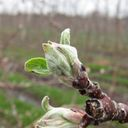 |
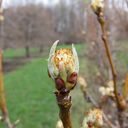 |
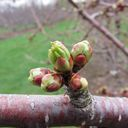 |
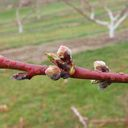 |
Upcoming meetings
May 17, 18, 19: Tree fruit twilight meetings, TBA
June 14, 15, 16: Tree fruit twilight meeting, TBA
July 18, 2011: Massachusetts Fruit Growers' Association Summer Meeting, Parlee Farms, Tyngsoboro, MA
The way I see it
Things still aren't moving too fast, but I expect based on the weather forecast, and for some areas of Massachusetts we will have some stone fruit bloom this weekend. According to NEWA, we have had 4 apple scab infection periods in Belchertown since green tip and ascospore maturity is at 14%. Most orchards will have received 2-3 fungicide sprays targeting scab through this week and ascospore maturity is predicted to be 37% by next Sunday:

In this week's Scaffolds Fruit Journal is an article about insects at pink. Rather than reprinting in it's entirety, here is a link to the article. It is good reading.
JC
2011 New England Tree Fruit Management Guide available
As a reminder, the 2011 New England Tree Fruit Management Guide is available for purchase here:
http://www.umass.edu/fruitadvisor/2011/2011netfmg.html
The 2011 New England Tree Fruit Management Guide (NETFMG) is available NOW. For $50 you will receive the printed guide by postal mail. You can download and print a mail-in form to order the NETFPMG by personal check here.
Note that for 2011 the herbicide/weed control section has been completely revised, and all sections have been carefully reviewed for changes in 2011. Order yours today!
Also note that Commonwealth Quality produce certified growers should have the 2011 NETFMG in their possession to achieve the maximum score!
NEWA highlight -- spotted tentiform leafminer
NEWA -- Network for Environment and Weather Applications
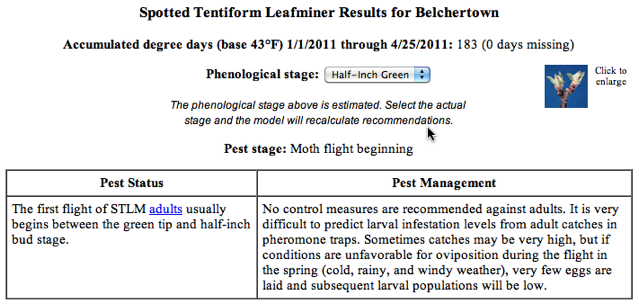
Guest Article -- Bitterpit control in apples
Low calcium levels are the source of bitterpit in apples.
Philip Schwallier and Amy Irish-Brown, Michigan State University Extension
Reprinted from MSU Extension News For Agriculture
Bitterpit is serious physiological disorder related to low calcium levels in the fruit (especially just under the peel). The major calcium effect in apple is the maintenance of membranes and cell wall structures, which, in turn, slows breakdown and maintains firmness of fruits. Bitterpit is the breakdown of the cells just under the peel where calcium levels are too low. Therefore, the focus for controlling bitterpit is on soil, leaf and ultimately fruit calcium. Some varieties (such as Cortland, Honeycrisp, Northern Spy, etc.) have a genetic susceptibility to Bitterpit. Bitterpit in other apple varieties is influenced by other factors, such as climate, orchard block characteristics and especially cropload/tree vigor. Soil calcium levels, soil pH, other nutrient levels, cropload balance, calcium sprays and postharvest calcium treatments all affect calcium levels in fruit. Increasing calcium levels in the fruit will reduce this disorder.
Fruitlets have high calcium levels in the spring but as the fruit grow in size, fruit calcium concentration decreases. Fruit will accumulate calcium over the entire season, but environmental conditions can still cause bitterpit problems. Soil applied lime and gypsum will increase fruit calcium, but need to be applied annually and results will be slow to detect (2 to 3 years). Generally, spray applications of foliar calcium periodically improves control but might not cure the disorder. It is important to start foliar calcium sprays right after petal fall and continue applications until harvest. Frequent calcium applications are better than less frequent, high-rate applications. Some years on some varieties, weather can overwhelm even the best calcium program. Postharvest drenches are important to help stop this disorder from developing further in storage.
Methods to increase calcium
- Keep soil pH at the optimum range for apples, 6.5 to 7.0.
- Lime with high-cal lime where needed. Keep soil levels abundant.
- Keep B and Zn levels at optimum levels as deficiencies will increase Ca disorders.
- Keep Mg and K levels at optimum levels as excessive levels increase Ca disorders.
- Consider Gypsum application in the early spring to provide luxury Ca.
- Use tissue analysis to identify Ca needs. Leaf should be 1.3% to 2%. 1.6% or greater is usually required to minimize disorders.
- Excessive pruning, excessive N, excessive vigor, low fruit loads and droughty conditions will increase bitterpit.
- Try to achieve uniform moderate tree vigor with annual moderate croploads.
- Apply calcium sprays to trees every two weeks, starting a week after petal fall.
- Use 1 to 2#/100 of CaCl2 early season and for the last 2 sprays, 2 to 4#/100.
- A seasonal rate of 7 to 14# Ca is desired.
- Avoid temperatures above 80 F. and especially when humidity is high.
- Maintain agitation in the tank when adding calcium.
- Watch out for compatibility with other products.
- Applications should be frequent and coverage complete. The calcium is taken in through the fruit skin and not the leaves.
- Calcium postharvest dips will put more calcium in an apple than a whole season of sprays.
- Apogee will help control vigor and may increase fruit Ca.
- Irrigation will reduce drought/Calcium stress.
Useful links
UMass Fruit Advisor http://www.umass.edu/fruitadvisor/
Scaffolds Fruit Journal http://www.nysaes.cornell.edu/ent/scafolds/
Network for Environment and Weather Applications (NEWA)
JMCEXTMAN Blog http://jmcextman.blogspot.com/
Follow me on Twitter http://twitter.com/jmcextman and Facebook http://www.facebook.com/jmcextman
